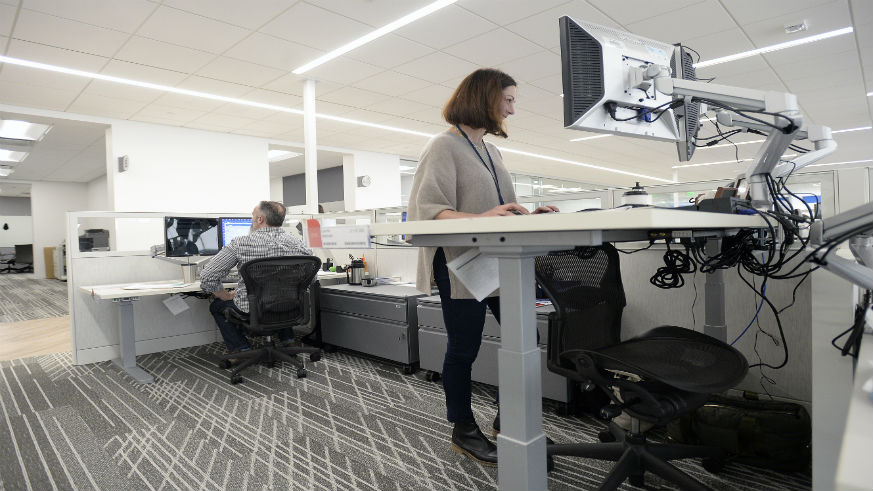Sitting at your desk seems like it might put you at low-risk for workplace injuries; how much can you possibly hurt yourself tapping on a keyboard?
Way more than you might think, it turns out. Working in an office involves hours of being sedentary, staring at a screen and repetitive motion, all of which can take their toll on your body. We talked to Arlette Loeser, a certified ergonomist and director of the injury prevention, ergonomics and accommodation at the Mount Sinai Selikoff Centers for Occupational Healthabout how to make your work setup as healthy as possible.

[Photo Credit: Getty Images]
What are some common workplace injuries?
Work-related aches, pains and workplace injuries can occur in different areas of the body including the different areas of the spine, neck, shoulders, forearms and fingers. Some examples of musculoskeletal workplace injuries seen at the Mount Sinai Selikoff Centers are: tendonitis, cubital tunnel syndrome, trigger finger, back and neck strain and spasms, herniated discs, visual strain and migraines. Many office workers are sore and achy and believe that discomfort is a norm from sitting at a computer, yet we believe that this is not necessarily correct. Work does not have to hurt!
How are these conditions treated?
Depending on the severity of the condition, treatment could be as conservative as a comprehensive workstation assessment, performed by certified ergonomist such as myself. An assessment identifies risk factors created by a poorly set up workstation and, unhealthy postures and work habits. Workstation changes can be all or a part of the treatment. Occupational health providers also refer patients for physical or occupational therapy include soft tissue release and therapeutic modalities, splints, injections and sometimes surgery.
Is sitting really the new smoking?
This headline got the attention of many who sit for most of their day, spreading concern about the health detriments of moving less while working at computer workstations. With a host of studies looking at sedentary lifestyle (not only work-related), researchers were able to identify areas impacted, such as reductions in insulin sensitivity, net calorie expenditure and overall cardiovascular health. Additionally, we confirmed concerns related to musculoskeletal decline leading to pain and stiffness because, as one moves less while working, there is less motivation to move more since it competes with computer task performance.
What can you do to protect yourself/prevent these issues?
As we continue to learn more about the wellness in the office environment, it is already clear that frequent bouts of movement — at least once every half hour — can promote health. Proper workstation setup, sitting in a chair that provides support and promotes good posture, and stretches performed at one’s workstation can help prevent workplace injuries. We encourage workers to commit standing up and leaving their workstation, which can be beneficial for even two minutes, but ideally five minutes, in order to increase heart rate and to loosen muscles. These practices apply to computer use in home environments as well.
What is the ideal ergonomic setup for your computer and desk? If you have a standing desk, how high should it be?
To start, there is great variability depending on the computer, whether desktop, laptop, single or multi-monitor, and the type of keyboard and mouse being used and how to use a sit-stand device or table.
For standard non-adjustable desks, check out our educational guideon our website, which includes tips on how to set computer workstations and select tips on how to promote healthy work behaviors to reduce aches and pains.
Sit-stand workstation design fosters position change and movement and should be used correctly and consistently. Improper use such as standing for hours at a time and fatiguing can be detrimental.
The standing height of the keyboard surface should enable the computer user to have their shoulders in a relaxed position with their elbows position at a right angle or greater. The mouse should be at the same level of the keyboard. The monitor’s height and distance should enable upright posture and accommodate to each person’s own visual needs. It is important to note that if one cannot can’t see well, they will lean forward or their head down, which can create neck pain. The goal is for computer user to easily view all active areas on the screen(s) while preventing exaggerated positions of their head and neck.



















